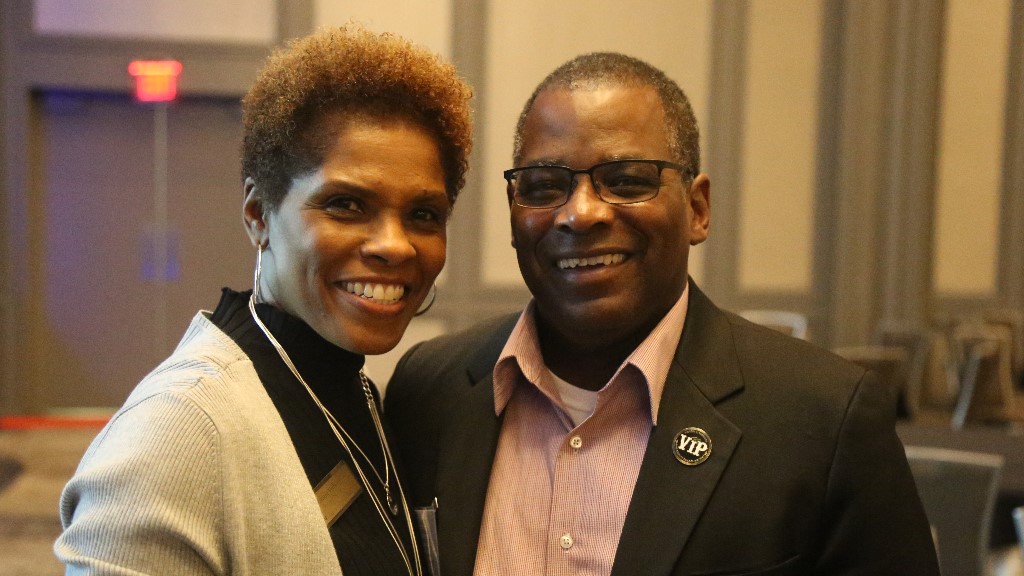School finance is a complex topic and often is difficult to explain, even for the most veteran school board member. The Alabama Association of School Boards (AASB) created a tool that its members can use to communicate district financial and demographic information easily.
To help school leaders in the state plan and focus on good governance and student achievement, the Georgia School Boards Association (GSBA), along with other state education partners, designed a coherent vision for public education in the state.
These two programs earned NSBA’s Leading Edge Award for 2019.
The recognition honors state school boards associations for creating statewide initiatives that provide needed services to support the work of local school boards.
“The Leading Edge Award recognizes the invaluable services our state associations provide to their local school boards,” NSBA Executive Director and CEO Thomas J. Gentzel said. “The School System Snapshot tool and Georgia Vision Project both advance public education’s mission by engaging partners in addressing critical issues in each state.”
School System Snapshots
Lanett City, on the Alabama side of the Chattahoochee River that borders Georgia, was once home of a thriving textile mill. When the industry took a downturn, so did the local economy. While the area is working to recover, Lanett City Schools, with fewer than 1,000 students and a 92 percent free and reduced-price lunch rate, offers programs to help its economically disadvantaged children.
A popular after-school program with proven results at W.O. Lance Elementary School was in danger of being cut when its three-year federal grant was not renewed. Principal Jamie L. Heard, who also serves on the Lanett City Council, made a case before the council to fund the program. One persuasive piece of his argument was the district’s Snapshot – a front and back printed flyer, which showed all the district’s financial information.
Heard “showed the snapshot of how we’re ranked in the state,” says Lanett City School Board member Gwendolyn Harris-Brooks, who is also vice president of the AASB board of directors. “They looked at it and immediately decided that they would sponsor this after-school program.”
The School System Snapshots program was started in 2016 by AASB for school board members to use when talking to their legislators and other leaders in their area about the needs of Alabama’s 137 school systems.
“It includes things like how many students you have, what is your debt ratio, how many buses you have, different things like that, your ranking in the state as far as per pupil expenditures, and all sorts of data that you need to know, but it’s hard to remember because there’s so much to remember, so many numbers,” says Connie Cox Spears, a member of the City of Madison Board of Education. Spears also serves on AASB’s advocacy committee. “It’s just a one-page snapshot that shows you all of the information for your school system, in a very condensed, very precise way,” she says.
“I looked at it as a way to give a common template for everyone, so that you could look system-to-system across the state and make comparisons and have some drilled-down information so they could talk about their systems,” says Lissa Tucker, AASB’s director of governmental relations.
When Alabama State Rep. Bill Poole, who is chair of the House Ways and Means Education Committee, first saw the Snapshots, he asked AASB to make 15 more Snapshot compilations for the members of his committee.
“The Snapshot contains the essential information on every critical aspect of every system in the State of Alabama,” says Poole. “As the Appropriations Chairman, to be able to identify critical information in districts around the state is a great assistance to me but also to each individual member of the Ways and Means Education Committee. It is an incredible resource in terms of putting information at policymakers’ fingertips.”
AASB staff collects the data each year from the state Education Department and does the layout and design of the Snapshots. A dedicated landing page on AASB’s website features downloadable copies of the Snapshots, as well as a list of the school systems’ one-mill property tax values to provide content for their tax capacity. The website also features an interactive map that allows users to compare Snapshots regionally.
“We think the Snapshot is an important investment, including the considerable investment of staff time and energy. One of our goals is to increase member engagement in the advocacy process. And we see the Snapshot is a tool to help school board members have that conversation with their lawmakers,” says AASB’s Executive Director Sally Smith.
“This project will help us have better-informed citizens, lawmakers and school board members, which we hope will lead to a greater investment in education at all levels.”
Georgia Vision Project
When Curtis Jones took the job as superintendent of Georgia’s Bibb County Schools in 2015, he was the seventh superintendent in five years. The district faced low graduation rates and public distrust of the schools that was reflected in a growing number of private schools in the region.
“When you have that many new superintendents, you have a lot of starts and stops, and we had gone through a major strategic planning process, and the community was tired of hearing ‘here’s what we now need to do, this is what you can do.’ So, I was fortunate that I was able to go in and say, ‘we’re not going to do all the vision work again. We’re just going to move forward and do the right work,’” says Curtis, who was named the 2019 National Superintendent of the Year. “Working with my senior cabinet, we put together a strategic plan that we were able to move forward with, and that plan in many ways was based upon the Vision Project.”

GSBA Executive Director Valarie Wilson and Bibb County Superintendent Curtis Jones
The Georgia Vision Project was developed through a partnership with GSBA and the Georgia Superintendents Association. “We wanted to come together as two associations to create a strategy or a vision for what we really believed about public education in this state,” says GSBA Executive Director Valarie Wilson.
The Vision Project promotes good governance, says Wilson, “because we know that everything begins at the top. We know that if you have a governance team – the superintendent and the board – that’s not working collaboratively together, you can’t have high student achievement because you don’t have a culture that is being successful.”
The seven components of the Vision Project are:
- Early Learning and Student Success
- Teaching and Learning
- Teaching and Learning Resources
- Human and Organizational Capital
- Governance, Leadership, and Accountability
- Culture, Climate, and Organizational Efficacy
- Financial Resources
“We didn’t just focus on academics. We focused on resources, and we also focused on human capital and its development,” says Director of the Georgia Vision Project Stan DeJarnett, who also serves as GSBA’s director of strategic planning. “Its comprehensive nature has been one factor that has earned such broad support from districts. The other factor is that it’s not too prescriptive. Boards can tailor the framework and really make it fit their personal needs without it getting too prescriptive in what boards should or what districts should or ought to be doing.”
GSBA commissioned Georgia State University to study the effectiveness of the Vision Project on student achievement. A cohort of doctoral students did their dissertations on how well the vision project worked in districts. Jami Berry, who is now a clinical assistant professor at the University of Georgia, supervised those students.
“We found in every district that the Vision Project was implemented with fidelity there were major changes for the good happening,” says Berry. “And those were especially related to instructional practices, but they trickled out into lots of other areas.”
She continues, “And what every one of the districts that we went out to was able to do was clearly articulate how these strands of the vision project were playing out in everyday practice both at the district level and at the classroom level.”
Another part of the project is Spark, an advocacy campaign to celebrate successes and change perceptions about public education in the state. “I truly believe if we don’t tell our stories, no one else will,” says Wilson.

GSBA Executive Director Valarie Wilson
In Bibb County, the campaign took the form of special lapel pins. VIP – Victory in Progress – pins are presented to administrators, teachers, and other staff in a formal ceremony. Those who receive the pins are committing to achieving the district’s goals and mission.
“We have this idea in Bibb that our value proposition is leadership, scholarship and citizenship. And we believe the VIP pin incorporates all of that,” says Jones. “I am so proud of that part of our campaign because it has branded us in a way that I never anticipated. People are proud of being able to say they’re VIP.”
Director of the Georgia Vision Project Stan DeJarnett
The Georgia Vision Project is widely supported in the state. More than 85 percent of Georgia school boards have a current Resolutions of Support in place for the project.
“At GSBA, we believe very strongly that you’ve got to have a strong strategic plan to get your work done, to make sure that you have like your blueprint for where you want to go, what you believe,” says Wilson. “We also believe strategic plans are important for your community, for your teachers, for your students, for your business leaders. It’s important to understand the role everybody plays to make sure children are successful."


Share this content